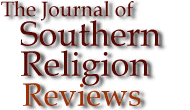

John Sparks, Elder John Sparks. The Roots of Appalachian Christianity: The Life and Legacy of Elder Shubal Stearns. University Press of Kentucky, 2002. 327 pages. Reviewed by Michael P. Ferber, West Virginia University, For the Journal of Southern Religion.
John Sparks brings the legend of Shubal Stearns, the man who evangelized the south, to life. Stearn's powerful piercing eyes, magnificent hywl cadenced voice, and his impeccable character are accurately reconstructed and replanted in an environment which mirrors the very cultural and spiritual context Deborah McCauley defines as the factors which shaped Appalachian Mountain Religion. Yet the author fails to completely convince this reader that Stearns is the "root" of Appalachian Christianity.
|
|
|
| "While Sparks greatly illuminates the biography of the influential Stearns, he falls short of convincing the reader of such a broad legacy." | |
|
|
Following a track from Connecticut to Virginia, Stearns journeyed to the Carolinas after receiving a call from God for a "Great work in the West." (pg. 48) The prophesy was quickly realized when twenty-one churches throughout the Carolinas and the Virginia Tidewater were planted to form the Sandy Creek Association, a connective over which Stearns reigned. However, due to a combination of internal and external forces, by 1769 the Association began to unravel as the congregations lost faith in the leadership of Stearns. Out-migration followed as former association members spread throughout the south and west and the legacy of Stearn's ministry, but not of Stearns himself, rooted itself in numerous denominations and sects throughout the region, including the Separate Baptists in Christ, Churches of Christ, Appalachian United Baptists, Appalachian Primitive Baptists, Old Regular Baptists, Mountain Free Will Baptists, Church of God Cleveland and its offshoots.
While Sparks greatly illuminates the biography of the influential Stearns, he falls short of convincing the reader of such a broad legacy. Over the course of the book this includes: 1) the tendency of displaced Appalachians to make pilgrimages back home (pg. 108), 2) the entire camp meeting culture (pg. 121), 3) the Appalachian rejection of missionaries as cold, remote, and aloof (pg. 197), 4) and finally Sparks claims, "the work of Stearns played its own part in unifying the entire Appalachian culture, secular as well as religious, into an entity as distinct as itself" (pg. 196). Clearly over-generalization is present, and one wonders whether Shubal also discovered Appalachian coal or marketed the first craft store! In addition, those of us who minister in Appalachia recognize the significance of church size. The Sandy Creek Church alone was populated by 590 members and the Little River Church had 500 members. Such large numbers are not a characteristic of Appalachian Mountain Religion, and Sparks does not attempt to address this issue.
The argument for assigning Stearns as the root of Appalachian Christianity might have been more effective had Sparks done more to assure the reader of the absolute historical accuracy of the life of the legendary Stearns. Phrases such as "appears to", "seems to have been", "evidently", "might", "a fair degree of probability", "we will never know for sure", "even if we had complete records of all that transpired", and "we know little or nothing of" do not solidify the foundation of the thesis. Yet, such historical honesty is purposeful and one must applaud the author's attempt to avoid the sins of the Landmarkians, which Sparks strongly criticizes, as he purposes "never to accept any religious historical document… at face value, without checking it against all other available and relevant sources." (pg. 291) So, in the end Stearns remains legendary. While his legacy may not entirely comprise "the roots" of Appalachian Christianity, it certainly is a significant contribution to the illumination of an important part of them. Sparks reveals an immense amount of historical fact to compliment this biography, and his work is extremely valuable.
Had this volume been written by an Appalachian scholar in a University setting it would be impressive. The fact that Sparks is a rural Appalachian pastor makes it more impressive still. Furthermore, while this critic is skeptical of the thesis, Sparks has opened the door for important scholarly debate and subsequent research, which might under further scrutiny prove to support his hypothesis. Hence, this book is of immeasurable importance and should grace the shelves of scholars and layman interested in Baptist history, Appalachian mountain religion, Appalachian history, and southern religion.
Michael Ferber, West Virginia University
© 1998-2003 by The Journal of Southern Religion. All rights reserved. ISSN 1094-5234